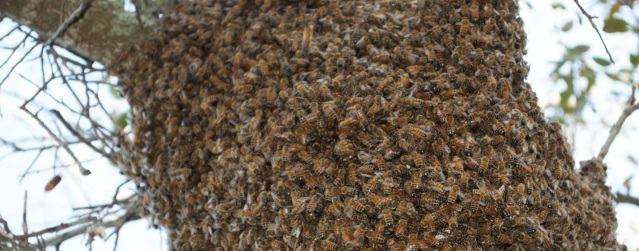
Swarm Removal
You see a cloud of bees on a blooming bush, gathering on a spilled sugary beverage or congregating on the edge of your swimming pool. The average person would most likely say “Look at that swarm of bees”. However, a beekeeper knows otherwise. They are just a large number of foragers, probably from several different hives, trying to get as much as they can before the source goes away.
So, “What is a swarm?” you ask. A swarm is a very specific entity in the life cycle of a beehive. It is a non-sexual mode of reproduction and has form and purpose. You need to know a little bit of bee biology to understand the events that lead up to swarm behavior.
A typical hive is made up of 40 to 60 thousand bees according to available space. The majority of these bees are non-fertile female worker bees who control the functioning of the hive. There are varying numbers of drones - males, who fly out each day looking for new queens from another hive that need to be bred. The third kind of bee is the fertile, egg-laying queen of which there is typically one per hive.
Bees communicate primarily through pheromones(odor) The queen's pheromone is distributed throughout the hive by mutual grooming. Her pheromone suppresses the ability of the worker females to lay eggs. The levels of queen pheromone in a hive can be affected by the number of bees and the health of the queen and some other factors. There is some contention as to functions of drone within the hive but their pheromone does appear to have some effect in stabilizing the hive. Worker bee pheromones are like little footprints. They leave tiny traces wherever they walk on the comb. So why do we care about pheromones? Pheromone levels are what trigger swarm behavior.
The swarm process begins when the population of the hive reaches a point where the queen pheromone is diluted by the sheer number of worker bees and the worker bee pheromone has exceeded the natural levels. When this happens, the workers will build a number of swarm cells which are special cells that are used to raise new queens. The queen will lay eggs in the cells and the workers will feed the larvae the restricted diet that will cause them to develop into queens. Not long before the new queens are due to emerge, the worker bees will stop feeding the old queen and chase her around the hive to get her into shape for flying.
When the time comes, the queen will be driven out of the hive and roughly half of the population will go with her. There will bees of all ages ready to start their specific duties in building a new hive. This is the SWARM. Usually, the swarm will leave the hive and muster in a tree, bush or structure not too far away while it chooses a potential new home from the choices that the scout bees have located. During this time the swarm will cluster tightly, protecting the queen. It can range from the size and shape of a football to something the size of a bushel basket. It can stay at this location for a couple of hours,days or sometimes a week or two depending on weather and site availability. When a new site is chosen, the swarm will move in, set up housekeeping and start the process all over again.
Now, you see a tight cluster of bees hanging somewhere. What do you do? We hope you would call a beekeeper. A swarm of bees is ordinarily pretty gentle and the beekeeper can easily shake or brush them into a hive and they will settle right in. However, you can choose to just leave them alone and like we said before they will leave on their own.
There is a good reason why you should contact a beekeeper when you see a swarm. When the swarm leaves, it has a destination. This could be a hollow tree, or if the bees find a crack, in your attic or in the walls of your house. Occasionally, they will build an open air hive in a sheltered area like the roof a barn or shed or the underside of a mobile home. While the bees may find the sites to be suitable, most humans do not care to have the bees as close neighbors.
Once the colony has established a hive in a location which you may find undesirable, the removal process can be a little more complicated. The removal of an open air hive can often be as simple as removing the comb and collecting the bees much like we do with a swarm. A colony in the walls of a structure most often has to be cut out and usually requires some carpentry skills. Bees in hollow trees or structures where cutting out is not an option, are often removed using a trap-out method which utilizes a one way entrance so bees can leave but not return to the hive. This usually takes a period of time.
It is important that you do not try to kill the bees in the hive. If the hive is sprayed, you will be left with a mass of fermenting honey, rotting dead bees and larvae, and lots of ants, roaches and beetles. Add mold and fungus and you have a horrible, smelly mess. In the case of a hollow tree, the bee hive can actually prolong the life of the tree. In the process of maintaining their hive, the bees will seal the inner surfaces of the hollow, keep beetles, ants and termites away and generally protect the tree from rot. Most often, bees in hollow trees are not removed unless they are low enough to cause problems in high traffic areas or if the tree is being removed.